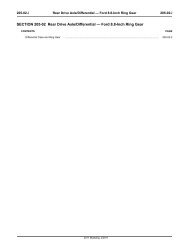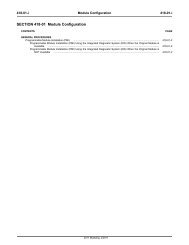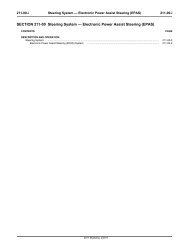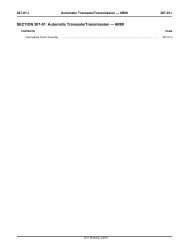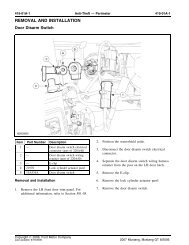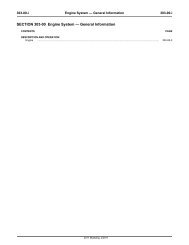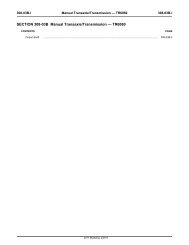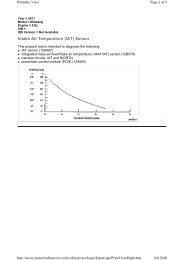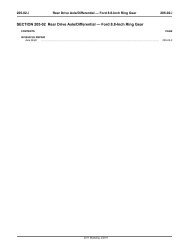Evaporative Emission (EVAP) Leak Check Monitor
Evaporative Emission (EVAP) Leak Check Monitor
Evaporative Emission (EVAP) Leak Check Monitor
Create successful ePaper yourself
Turn your PDF publications into a flip-book with our unique Google optimized e-Paper software.
leak exists.<br />
4. If the initial target vacuum cannot be reached, DTC P0455 (gross leak detected) is set. The engine on<br />
<strong>EVAP</strong> leak check monitor aborts and does not continue with the leak check portion of the test.<br />
For some vehicle applications, if the initial target vacuum cannot be reached after a refueling event<br />
and the purge vapor flow is excessive, DTC P0457 (fuel cap off) is set. If the initial target vacuum<br />
cannot be reached and the purge flow is too small, DTC P1443 (no purge flow condition) is set.<br />
If the initial target vacuum is exceeded, a system flow concern exists and DTC P1450 (unable to<br />
bleed-up fuel tank vacuum) is set. The engine on <strong>EVAP</strong> leak check monitor aborts and does not<br />
continue with the leak check portion of the test.<br />
If the target vacuum is obtained on the fuel tank, the change in the fuel tank vacuum (bleed-up) is<br />
calculated for a calibrated period of time. The calculated change in fuel tank vacuum is compared to a<br />
calibrated threshold for a leak from a hole (opening) of 1.016 mm (0.040 inch) in the enhanced <strong>EVAP</strong><br />
system. If the calculated bleed-up is less than the calibrated threshold, the enhanced <strong>EVAP</strong> system<br />
passes. If the calibrated bleed-up exceeds the calibrated threshold, the test aborts. The test can be<br />
repeated up to 3 times.<br />
If the bleed-up threshold is still being exceeded after 3 tests, a vapor generation test must be carried<br />
out before DTC P0442 (small leak detected) is set. This is accomplished by returning the enhanced<br />
<strong>EVAP</strong> system to atmospheric pressure by closing the <strong>EVAP</strong> canister purge valve and opening the CV<br />
solenoid. Once the FTP sensor observes the fuel tank is at atmospheric pressure, the CV solenoid<br />
closes and seals the enhanced <strong>EVAP</strong> system.<br />
The fuel tank pressure build-up, over a calibrated period of time is compared to a calibrated threshold<br />
for pressure build-up due to vapor generation.<br />
If the fuel tank pressure build-up exceeds the threshold, the leak test results are invalid due to vapor<br />
generation. The engine on <strong>EVAP</strong> leak check monitor attempts to repeat the test again.<br />
If the fuel tank pressure build-up does not exceed the threshold, the leak test results are valid and<br />
DTC P0442 is set.<br />
5. If the 1.016 mm (0.40 inch) test passes, the test time is extended to allow the 0.508 mm (0.020 inch)<br />
test to run.<br />
The calculated change in fuel vacuum over the extended time is compared to a calibrated threshold<br />
for a leak from a 0.508 mm (0.020 inch) hole (opening).<br />
If the calculated bleed-up exceeds the calibrated threshold, the vapor generation test is run. If the<br />
vapor generation test passes (no vapor generation), an internal flag is set in the PCM to run a 0.508<br />
mm (0.020 inch) test at idle (vehicle stopped).<br />
On the next start following a long engine off period, the enhanced <strong>EVAP</strong> system is sealed and<br />
evacuated for the first 10 minutes of operation.



